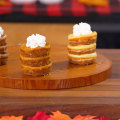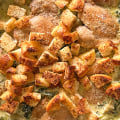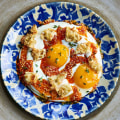Ingredients
- 1 rack lamb (about 2 pounds)
- 1/4 cup extra virgin olive oil
- 2 cup garlic cloves
- 1 tablespoon smoked paprika (pimentón)
- 1 tablespoon medium slice rye bread, broken into pieces
Preparation
Baking Directions:
1.Heat the oven to 450° F.
Trim the lamb of excess fat, but leave a layer of fat over the meat.
Cut about halfway down the bones between the chops; this allows the meat between them to become crisp.
2.Put the oil, garlic, paprika and a sprinkle of salt and pepper in a food processor and purée; add the bread and pulse a few times to make rough crumbs.
Rub this mixture over the meat side of the rack and sprinkle with more salt and pepper.
Put it in a roasting pan and put in the oven; roast for 18 to 20 minutes and insert an instant-read meat thermometer straight in from one end into the meatiest part.
If it reads 125° F or more, remove the lamb immediately.
If it reads less, put the lamb back for 5 minutes, no more.
Remove and let sit for 5 minutes.
Serve, separating the ribs by cutting down straight through them.
Tips:
Always trim the excess fat and roast at extremely high heat.
If you get really good quality lamb, all you really need for flavoring is salt and pepper.
If you've only eaten rack of lamb in restaurants, you've probably been served a whole rack, six to eight ribs, but I find even a small rack will serve three or four people if you have sides to go with it.
If you're entertaining and cooking for more — cook two racks at a time; they will fit side by side in most roasting pans.
(I cut each rack in half before roasting, which makes for slightly more uniform cooking and relieves the busy host from having to separate the individual servings at the last minute.)
I cut most of the way down between the ribs so that more meat is exposed to intense heat and therefore becomes crisp.
(Frenching the ribs, or scraping the meat off the bones to make them look neater, is counterproductive; the crisp meat on the bones is one of the joys of rack of lamb).




